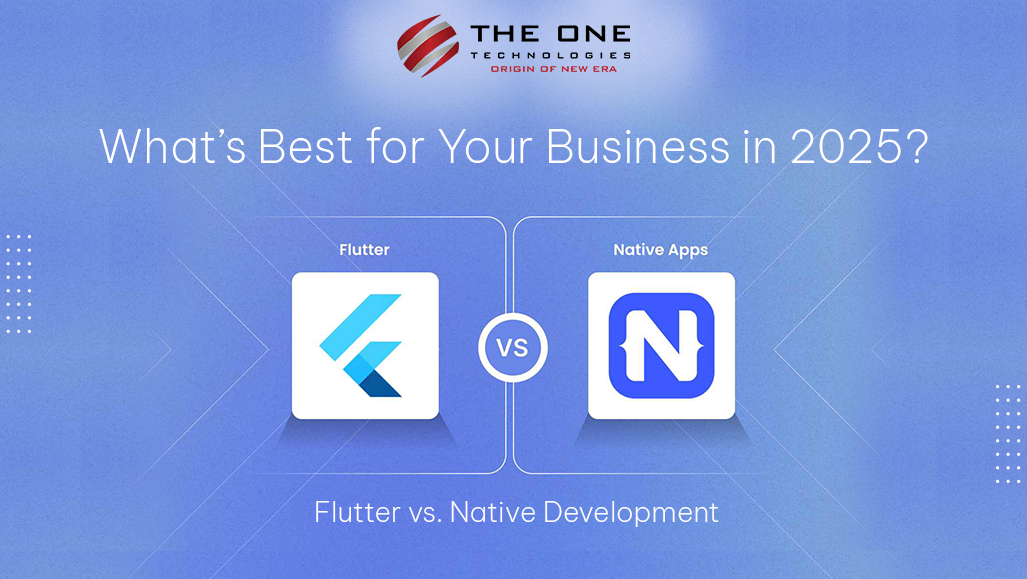Flutter vs. Native Development in 2025

In the digital world of today, mobile apps are not a supplement to your business. They're usually the epicenter of your digital strategy. You're a startup or a long-standing enterprise; your choice of development methodology is a critical one. And in 2025, the Flutter vs. native development debate is more pertinent than ever.
Let’s break down what each option offers to help you determine the right fit for your business needs—especially if you're looking to hire a Flutter developer.
Understanding the Basics
Google's open-source UI framework, Flutter, enables developers to build natively compiled desktop, web, and mobile applications from a shared codebase. It was developed in Dart and has become very popular because of its expressive user interface, rapid development cycles, and native-like performance.
But the process of developing standalone apps for iOS and Android using platform-specific tools and languages such as Java or Kotlin for Android and Swift or Objective-C for iOS is known as native development. Although this approach usually offers the best device feature and performance access, it is at the expense of additional development time and dollars.
Key Comparison Areas
1. Performance
Native: Native development is still the best option if the highest level of performance is required, as in the case of gaming applications, high-end AR/VR, or highly animated apps. The app can fully utilise the hardware and operating system features of the device because it is specifically made for the platform.
Flutter: Flutter applications are remarkably near native performance because of their leverage of Dart and Skia (its own engine for rendering). For the typical business use case, eCommerce, social networking, fintech, or productivity apps. The gap in performance doesn't matter at all.
Winner:Native (for high-performance needs), Flutter (for most standard use cases)
2. Development Speed and Cost
Native: Creating two independent codebases equals double the effort, time, and cost. You'll need iOS and Android developers, independent testing, and concurrent maintenance.
Flutter: You can write once and deploy anywhere with Flutter. This makes it a good choice for startups or businesses looking to enter the market quickly because it drastically reduces development time and cost. If you want to leverage these benefits, you should hire Flutter app developers to build your cross-platform app efficiently.
Winner:Flutter
3. UI and User Experience
Native: Native development allows full control over UI components and access to the latest design elements and platform conventions. This results in highly polished user experiences that align perfectly with each OS’s guidelines.
Flutter: You can create highly customisable user interfaces with Flutter's widget-based architecture, which even accurately replicates native components. However, it might take more work to keep up with minor design changes in iOS or Android.
Winner:Native (slightly ahead for platform-specific design), Flutter (for unique, custom UIs)
4. Access to Device Features
Native: Native development offers native integration and early access to platform-specific functionality if your application significantly depends on native APIs like the camera, GPS, Bluetooth, biometrics, or sensors.
Flutter: Flutter gives access to device features through plugins, and the plugin base has developed a lot. Yet, for brand-new or highly specialized device features, there could be a lag or writing custom platform-specific code.
Winner:Native
5. Community and Ecosystem
Flutter: Flutter has an enormous and increasing worldwide developer population as of 2025. Google's constant investment in the framework guarantees that there are consistent updates, improved tooling, and a very large package repository.
Native: iOS and Android development communities are mature and large. Apple and Google offer abundant documentation and tools for development.
Winner:Tie
What’s Changed in 2025?
In 2025, Flutter has grown into a stable option not only for MVPs or cross-platform applications, but also for enterprise projects. Tooling has gotten better, performance has stabilized, and numerous big companies (such as BMW, Alibaba, and eBay) have started using Flutter in production.
Native development, on the other hand, is still the gold standard for applications that require top performance, extensive integration with device hardware, or platform-specific features introduced in beta.
So, Which One is Right for Your Business?
Ask yourself the following:
- Speed to Market: Do you need to launch quickly and on both platforms? → Flutter.
- Budget Constraints: Do you want to save costs without sacrificing quality? → Flutter.
- User Experience Precision: Is pixel-perfect UI/UX on each platform crucial? → Native.
- Heavy Device Integration: Does your app rely on specific hardware capabilities? → Native.
- Future Maintenance: Do you want to manage a single codebase long-term? → Flutter.
The Conclusion
Between Flutter and native development in 2025, the choice is not necessarily which is better overall, but rather which is better for your business needs.
If you want faster deployment, simpler maintenance, and decent performance across platforms, hire Flutter app developers to build a cost-effective, cross-platform solution. If you're developing a highly complex, hardware-heavy app where platform-specific performance matters, native remains an option.
Ultimately, the best strategy is one that fits your business goals, development resources, and future product roadmap. Struggling to select the proper tech for your app concept? Speak with our mobile expert consultants now and receive a complimentary roadmap that suits your objective.



_638829999665276850.png)





